Text
Creature Awaits #246
Each week I plan to feature an amazing creature, admiring God's fantastic artistry. Hopefully it’ll brighten someone’s day to see something new and interesting if they haven’t seen it before. : )
As the Pantone color of the year is "Peach Fuzz", so we'll dive into the second month of this relatively new year by featuring creatures of this cozy, comforting color. : )

(Beautiful photography by Luiz Lapa (CC BY 2.0 Deed))
The Eurasian Bullfinch
Scientific Name: Pyrrhula pyrrhula
Region: Throughout Europe and temperate regions across Asia
Size: About 6" (~15.2cm) tall
Interesting Notes: In many English-speaking parts of Europe, this is bright and beautiful bird is simply known as a Bullfinch, as it was the first bird to be given that name. There are now a handful of both Old and New World bullfinches. The peach belly and grey back only appears on the male, these parts are a soft, pale brown on females, though the black markings remain in similar locations.
#creatureawaits#beautiful birds#beautiful animals#cute animals#Eurasian Bullfinch#Bullfinch#Common Bullfinch#Pyrrhula pyrrhula
1 note
·
View note
Text
Creature Awaits #245
Each week I plan to feature an amazing creature, admiring God's fantastic artistry. Hopefully it’ll brighten someone’s day to see something new and interesting if they haven’t seen it before. : )
As the Pantone color of the year is "Peach Fuzz", so we'll dive into the second month of this relatively new year by featuring creatures of this cozy, comforting color. : )

(Fantastic capture taken by skilled-photographer, Rushen (CC BY-SA 2.0 Deed))
The Black-Headed Cat Snake
Scientific Name: Boiga nigriceps
Region: Rainforests throughout Borneo, Western Indonesia, southern Thailand and West Malaysia
Size: Up to about 5'6" (~1.75m) long
Interesting Notes: By adulthood, this beautiful snake's head has darkened to somewhere between olive green and black. Its body color can range anywhere from pale peach to red to black, though its belly is always pale with yellow under its neck. Though it primarily lives in trees, it will descend to the rainforest floor in search of prey as often as needed.
#creatureawaits#beautiful animals#elegant animals#hide#beautiful snakes#Black-Headed Cat Snake#Boiga nigriceps
1 note
·
View note
Text
Creature Awaits #244
Each week I plan to feature an amazing creature, admiring God's fantastic artistry. Hopefully it’ll brighten someone’s day to see something new and interesting if they haven’t seen it before. : )
As the Pantone color of the year is "Peach Fuzz", so we'll dive into the second month of this relatively new year by featuring creatures of this cozy, comforting color. : )

(A beautiful capture taken by Jörg Hempel (CC BY-SA 3.0 DE Deed))
The Blue-Tailed Damselfly
A.K.A: The Common Bluetail
Scientific Name: Ischnura elegans
Region: Near still or slow waters throughout Europe and the Middle East
Size: About 1.1"-1.4" (~2.7cm-3.5cm) long with a roughly 1.4" (~3.5cm) wingspan
Interesting Notes: Interestingly, while male adults of this species are primarily blue and black, and female adults are either the same or sport a green or brown thorax, juvenile females of this species can range widely in color. They are generally lighter in tone overall and can range anywhere from violet to green to peach (as pictured.) : )
#creatureawaits#beautiful animals#beautiful insects#elegant animals#interesting animals#Blue-Tailed Damselfly#Common Bluetail#Ischnura elegans#peach animals
1 note
·
View note
Text
Creature Awaits #243
Each week I plan to feature an amazing creature, admiring God's fantastic artistry. Hopefully it’ll brighten someone’s day to see something new and interesting if they haven’t seen it before. : )
As the Pantone color of the year is "Peach Fuzz", so we'll dive into the second month of this relatively new year by featuring creatures of this cozy, comforting color. : )

(Gorgeous still taken by talented photographer, Christian Gloor (CC BY 2.0 Deed))
The Pink Skunk Clownfish
A.K.A: The Pink Anemonefish
(Yes, despite the name, it's actually more peach in hue. : ) )
Scientific Name: Amphiprion perideraion
Region: Reef lagoons and slopes across the western Pacific and eastern Indian oceans
Size: Up to about 3.9" (~10cm)
Interesting Notes: Unlike many anemonefish species, the Pink Skunk Clownfish, one of the smallest anemonefish, is willing to share its anemone host home with another species. : )
#creatureawaits#beautiful animals#beautiful fish#peach fuzz#Pink Skunk Clownfish#cute animals#Pink Anemonefish#Amphiprion perideraion
1 note
·
View note
Text
Creature Awaits #242
Each week I plan to feature an amazing creature, admiring God's fantastic artistry. Hopefully it’ll brighten someone’s day to see something new and interesting if they haven’t seen it before. : )
The Pantone color of the year is "Peach Fuzz", so we'll dive into the second month of this relatively new year by featuring creatures of this cozy, comforting color. : )

(Stunning photography by Arttu (CC BY-NC 2.0 Deed))
The Moluccan Cockatoo
A.K.A: The Salmon-Crested Cockatoo
Scientific Name: Cacatua moluccensis
Region: Seram Island of Indonesia originally, though it is an introduced species to Oahu, Hawaii
Size: About 1.5'-1.7' (~46cm-52cm) tall
Interesting Notes: This pale peach parrot boasts one of the loudest calls of any bird worldwide at up to over 120dB - loud enough to possibly damage someone's hearing and comparable to a thunderclap or fireworks.
Sadly, this highly-intelligent, sociable and gentle bird's numbers in the wild sharply declined due an abundance of illegal unauthorized capture for the pet trade; however, protective efforts have been put in place to hopefully help these wild populations recover over time. (…Hopefully soon!)
#creatureawaits#beautiful animals#beautiful birds#elegant animals#Moluccan Cockatoo#Salmon-Crested Cockatoo#Cacatua moluccensis#animals of Indonesia
2 notes
·
View notes
Text
Creature Awaits #241
Each week I plan to feature an amazing creature, admiring God's fantastic artistry. Hopefully it’ll brighten someone’s day to see something new and interesting if they haven’t seen it before. : )
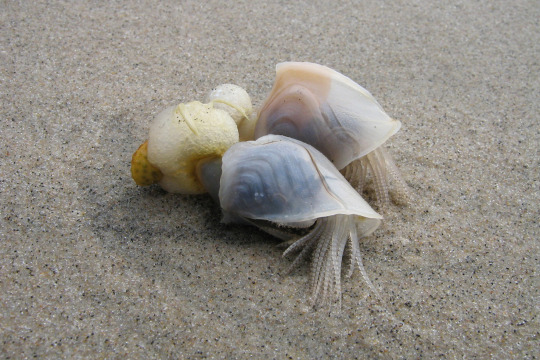
(Beautiful photograph taken by WestPark (CC BY-NC-ND 2.0 Deed))
Buoy Barnacles
Scientific Name: Dosima fascicularis
Region: Temperate waters across the Atlantic and Pacific
Size: About a .47"-.78" (~1.2cm-2cm) long shell portion
Interesting Notes: If unable to find a suitable floating surface to attach itself to, this delicate and unique barnacle secretes a gas-filled cement, creating its own natural float. It is the only known barnacle to do this. This structure is the pale yellow shape, similar in appearance to expanding foam, visible at left in the photo above. (Hopefully the little guys pictured found their way back to the sea after this photograph was taken! : ) )
#creatureawaits#beautiful animals#elegant animals#interesting animals#translucent animals#Buoy Barnacles#Dosima fascicularis
1 note
·
View note
Text
Creature Awaits #240
Each week I plan to feature an amazing creature, admiring God's fantastic artistry. Hopefully it’ll brighten someone’s day to see something new and interesting if they haven’t seen it before. : )

(Awesome photograph by Sarah H. Olson and the rest of the team at the Wildlife Conservation Society (CC0 1.0 Deed))
The Hammer-Headed Bat
Scientific Name: Hypsignathus monstrosus
Region: A region of western central Africa
Size: About a 3'4" (~1.0m) wingspan
Interesting Notes: The males of this unique fruit bat species, the largest of continental Africa, have a large resonating chamber in their snout used in producing loud honking noises to attract potential mates. Females of the species look more like other fruit bat species, and weigh roughly half their male counterparts' weight.
#creatureawaits#beautiful animals#interesting animals#bats#fruit bats#megabats#Hammer-Headed Bat#Hypsignathus monstrosus
4 notes
·
View notes
Text
Creature Awaits #239
Each week I plan to feature an amazing creature, admiring God's fantastic artistry. Hopefully it’ll brighten someone’s day to see something new and interesting if they haven’t seen it before. : )
We're back after a two-week hiatus for Christmas and New Year's! Hope you all had a beautiful Holiday!! Happy New Year!!


(Elegant photography by Bernard Dupont (CC BY-SA 2.0 Deed))
The Blue Crane
A.K.A: The Stanley Crane, The Paradise Crane
Scientific Name: Grus paradisea
Region: Primarily South Africa, with a smaller population in Namibia
Size: About 3'3"-3'11" (~100cm-120cm) tall, with a 5'11"-6'7" (~180cm-200cm) wingspan
Interesting Notes: This elegant bird - the national bird of South Africa - holds an important place culturally amongst both the Xhosa and Zulu. The bird's picturesque plumes are worn in the hair and headdresses of both peoples. The Xhosa decorate those considered "Men of Trouble" with these feathers to signify them being tasked with keeping peace among their people, while the Zulu use them to honor noble warriors and kings.
#creatureawaits#beautiful animals#beautiful birds#elegant animals#interesting animals#blue crane#blue animals#stanley crane#paradise crane#Grus paradisea
1 note
·
View note
Text
Creature Awaits #238
Each week I plan to feature an amazing creature, admiring God's fantastic artistry. Hopefully it’ll brighten someone’s day to see something new and interesting if they haven’t seen it before. : )
We continue this year's Christmas-time theme…"Peppermint" where we'll feature beautiful animals sporting Red and White. : )

(Adorable still taken by Tubifex (CC BY-SA 3.0 Deed))
The Anthony's Poison Arrow Frog
Scientific Name: Epipedobates anthonyi
Region: The western border between Equador and Peru
Size: Only about 0.7"-1" (~19mm-26mm) long
Interesting Notes: The female of this tiny, peppermint-colored frog will lay her eggs under leaves on the forest floor. The male will then guard them for two weeks until they hatch into tadpoles, and then will carry them on his back to the water they will live in until emerging as fully grown frogs two months later.
#creatureawaits#cute animals#peppermint color#red and white animals#frogs#poison arrow#Anthony's Poison Arrow Frog#Epipedobates anthonyi
0 notes
Text
Creature Awaits #237
Each week I plan to feature an amazing creature, admiring God's fantastic artistry. Hopefully it’ll brighten someone’s day to see something new and interesting if they haven’t seen it before. : )
We continue this year's Christmas-time theme…"Peppermint" where we'll feature beautiful animals sporting Red and White. : )
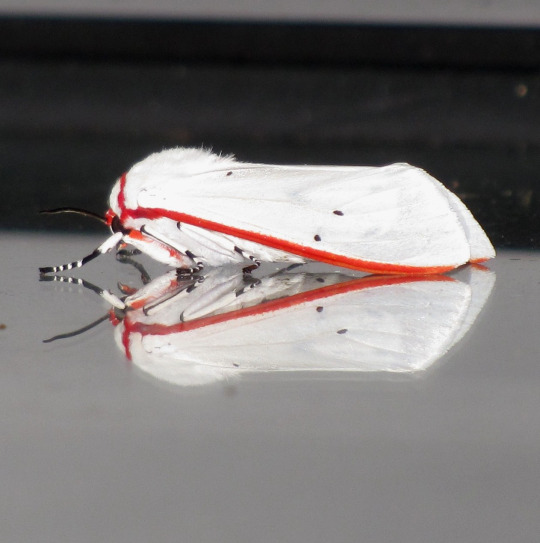
(Beautiful photography by Vaikoovery (CC BY 3.0 Deed))
The Red Costate Tiger Moth
Scientific Name: Aloa lactinea
Region: Throughout southeast Asia
Size: About 1.6" (~40mm) long
Interesting Notes: Though destined to grow into a beautiful moth, sadly the caterpillar phase of this gorgeous insect is somewhat considered a pest - feeding on a variety of crops including coffee, sunflowers, sweet potatoes and beans.
#Red Costate Tiger Moth#Aloa lactinea#creatureawaits#beautiful insects#elegant animals#red and white animals#red and white insects#peppermint#Christmas
1 note
·
View note
Text
Creature Awaits #236
Each week I plan to feature an amazing creature, admiring God's fantastic artistry. Hopefully it’ll brighten someone’s day to see something new and interesting if they haven’t seen it before. : )
Due to personal and work-related issues, I missed posting last week, so we're getting a double-post this week to make up for it. Apologies for the delay again! Hopefully things will be better again soon. : )
Second, the start of this year's Christmas-time theme…"Peppermint" where we'll feature beautiful animals sporting Red and White. : )
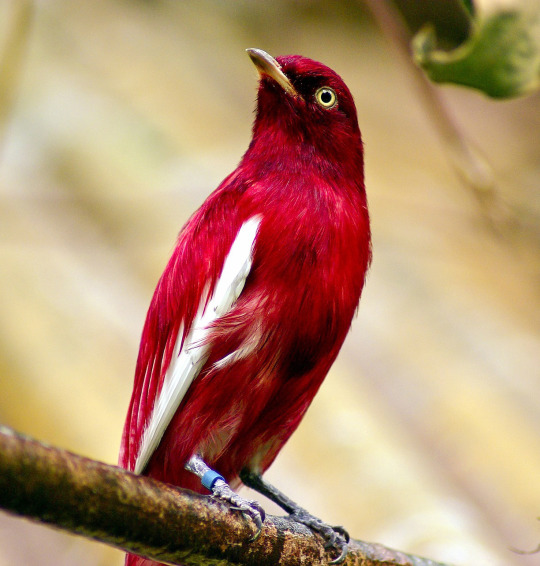
(Brilliant photograph taken by skilled photographer, Mike Goad (CC0 1.0 Deed))
The Pompadour Cotinga
Scientific Name: Xipholena punicea
Region: Central northern South America
Size: About 7.8" (~20cm) long
Interesting Notes: The preferred habitat of this brilliant bird is the relatively rare subtropical varillal biome - unique white sand forests found only in the Amazon Basin of South America, Maputaland of South Africa and in Malasia and Indonesia of Asia. Another sexually dimorphic species, female Pompadour Cotingas have grey in place of the red found in males.
#creatureawaits#beautiful animals#beautiful birds#elegant animals#peppermint#red and white animals#varillal
0 notes
Text
Creature Awaits #235
Each week I plan to feature an amazing creature, admiring God's fantastic artistry. Hopefully it’ll brighten someone’s day to see something new and interesting if they haven’t seen it before. : )
Due to personal and work-related issues, I missed posting last week, so we're getting a double-post this week to make up for it. Apologies for the delay again! Hopefully things will be better again soon. : )
First, our final November camouflaged creature feature… : )

(Beautifully photographed by the talented, Brian Gratwicke (CC BY-NC 2.0 Deed))
The Vietnamese Mossy Frog
Scientific Name: Theloderma corticale
Region: Northern Vietnam through southern Laos and China
Size: About 2.4" (~6.1cm) long
Interesting Notes: This beautiful little frog's bumpy skin and mottled markings help it seamlessly blend into mossy forest floors and lichenous rock facings alike.
#creatureawaits#camouflage#interesting animals#cute animals#frogs#Vietnamese mossy frog#Theloderma corticale
0 notes
Text
Creature Awaits #234
Each week I plan to feature an amazing creature, admiring God's fantastic artistry. Hopefully it’ll brighten someone’s day to see something new and interesting if they haven’t seen it before. : )
For November we'll be exploring some uniquely camouflaged creatures… : )

(Awesome capture by the talented, Richard Ling (CC BY-NC-ND 2.0 Deed))
The Reef Stonefish
Scientific Name: Synanceia verrucosa
Region: Coral Reefs throughout the Indo-Pacific and Red Sea
Size: Usually up to 11" (~27cm) long
Interesting Notes: Perhaps one of the most effective hunters of the sea, the Reef Stonefish, in addition to its ability to strike at heedless passing prey at bizarrely high speeds, blends near-perfectly into its colorful coral home. It's also one of the sea's most dangerous fish to humans as its dorsal spines contain an extremely toxic venom primarily used for self-defense against predators.
(If you're having trouble seeing it - look for the "frowning" mouth towards the bottom of the red, then look up a bit from the sides of it to find the two small eyes. : ) )
2 notes
·
View notes
Text
Creature Awaits #233
Each week I plan to feature an amazing creature, admiring God's fantastic artistry. Hopefully it’ll brighten someone’s day to see something new and interesting if they haven’t seen it before. : )
(Sorry I had some things come up so this is a day late, but hopefully it was worth the wait! : ) )
For November we'll be exploring some uniquely camouflaged creatures… : )
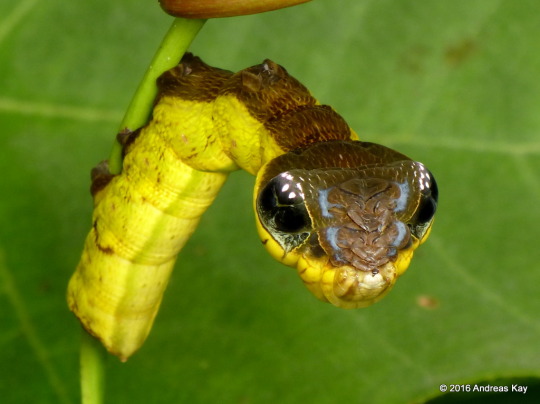
(Fantastic photography by Andreas Kay (CC BY-NC-SA 2.0 Deed))
Hemeroplanes triptolemus and Its Snake-Mimicking Caterpillar Stage…
Scientific Name: Hemeroplanes triptolemus
Region: Mexico, Belize, Costa Rica & Guatemala
Size: Only about 1" (~2.5cm) long
Interesting Notes: When feeling threatened, the caterpillar phase of Hemeroplanes triptolemus, a species in the Sphinx Moth (a.k.a. Hawk Moth) family, leans backwards and puffs out its upper sides to reveal markings closely resembling a snake's head. It even attempts mimic the motion of a snake rearing to strike - hopefully chasing away any and all potential predators..
#creatureawaits#cute animals#beautiful insects#camouflage#Hemeroplanes triptolemus#Snake-Mimicking Caterpillar#Sphinx Moth#Hawk Moth
3 notes
·
View notes
Text
Creature Awaits #232
Each week I plan to feature an amazing creature, admiring God's fantastic artistry. Hopefully it’ll brighten someone’s day to see something new and interesting if they haven’t seen it before. : )
For November we'll be exploring some uniquely camouflaged creatures… : )

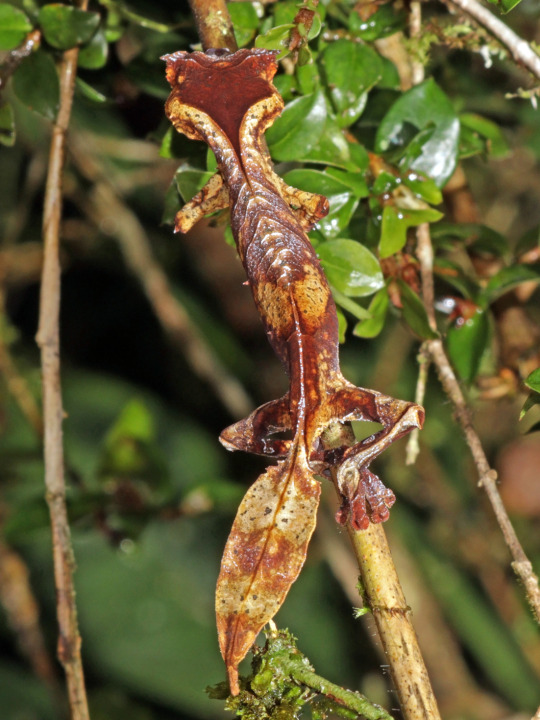
(An awesome captures by skilled photographer, Charles J. Sharp (CC BY-SA 4.0 Deed, cropped))
The Phantastic Leaf-Tailed Gecko
A.K.A: The Satanic Leaf-Tailed Gecko, The Eyelash Leaf-Tailed Gecko
Scientific Name: Uroplatus phantasticus
Region: Tropical forests along central eastern Madagascar
Size: Only about 3.5" (~9cm) long, including their leafy tail
Interesting Notes: These remarkable little leafy reptiles are so well camouflaged, that, when remaining still, both predators and prey struggle to see them. Not only do they sport the warm colors and markings of fallen leaves, but even their skin's texture contains leaf-like veining. Interestingly, there is a tendency in males of the species to also have notches in their tails as though decomposing, but most female tails appear more intact.
#creatureawaits#beautiful animals#Phantastic Leaf-Tailed Gecko#Satanic Leaf-Tailed Gecko#Eyelash Leaf-Tailed Gecko#Uroplatus phantasticus#camouflage
3 notes
·
View notes
Text
Creature Awaits #231
Each week I plan to feature an amazing creature, admiring God's fantastic artistry. Hopefully it’ll brighten someone’s day to see something new and interesting if they haven’t seen it before. : )
Continuing our October series.. "Cute…but Deadly" : )

(Beautiful photography by Jeff Lipshitz of the Channel City Camera Club (CC BY 2.0 Deed))
The Leopard Seal
Scientific Name: Hydrurga leptonyx
Region: The Antarctic
Size: About 7.9'-11.5' (~2.4m-3.5m) long & weigh about 440lb-1,320lb (200kg-600kg)
Interesting Notes: Though adorable at a distance, Leopard Seals can definitely be deadly up close. Though attacks on humans are rare, there are recorded instances of these strong and beautiful creatures attacking inflatable boats and biting, and even dragging, explorers and scientists into dangerous icy waters.. However, not all tales of their encounters with humans end in tragedy. One such story, documented in 2006, involved Paul Nicklen, a photographer for National Geographic, who dove among them, capturing their daily life. A female Leopard Seal took notice of Nicklen, and for four days, took pity on him as "a helpless predator" and brought him food. She brought dead penguins at first and then switched to injured ones - thought to be a way to teach him to hunt for himself. Nicklen stated the experience will "stay with him forever."
You can read more on the experience and see his photography on the National Geographic website here:
https://www.nationalgeographic.com/adventure/article/140311-paul-nicklen-leopard-seal-photographer-viral
10 notes
·
View notes
Text
Creature Awaits #230
Each week I plan to feature an amazing creature, admiring God's fantastic artistry. Hopefully it’ll brighten someone’s day to see something new and interesting if they haven’t seen it before. : )
Continuing our October series.. "Cute…but Deadly" : )

(An awesome capture by Eric Polk (CC BY-SA 4.0 Deed))
The Bloody-belly Comb Jelly
Scientific Name: Lampocteis cruentiventer
Region: The Northern Pacific Ocean, usually between about 820'-4,921' (~250m-1,500m) deep
Size: About 6" (~16cm) long
Interesting Notes: As a comb jelly, this bizarrely beautiful creature doesn't move like a true jellyfish, but propels itself by rhythmically waving rows of hair-like cilia. Being totally translucent, its stomach's deep red color - one of the hardest colors to see at this ocean depth - stealthily keeps predators from spotting any bioluminescent meals still digesting within its stomach. Like its fellow comb jellies, instead of stinging its prey, it produces an extremely sticky, glue-like substance that holds its prey captive as it's slowly dragged into its mouth.
#creatureawaits#beautiful animals#elegant animals#comb jellies#bloody-belly comb jelly#Lampocteis cruentiventer#translucent animals#bioluminescence#stealthy animals
3 notes
·
View notes